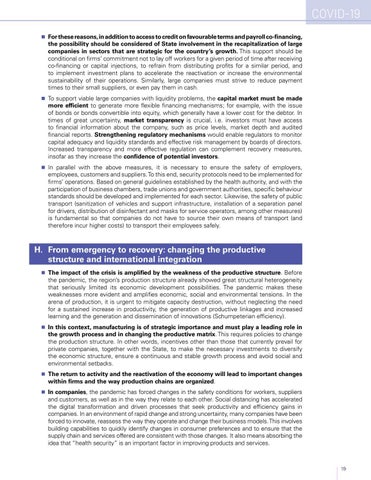COVID-19 For these reasons, in addition to access to credit on favourable terms and payroll co-financing,
the possibility should be considered of State involvement in the recapitalization of large companies in sectors that are strategic for the country’s growth. This support should be conditional on firms’ commitment not to lay off workers for a given period of time after receiving co-financing or capital injections, to refrain from distributing profits for a similar period, and to implement investment plans to accelerate the reactivation or increase the environmental sustainability of their operations. Similarly, large companies must strive to reduce payment times to their small suppliers, or even pay them in cash. To support viable large companies with liquidity problems, the capital market must be made
more efficient to generate more flexible financing mechanisms; for example, with the issue of bonds or bonds convertible into equity, which generally have a lower cost for the debtor. In times of great uncertainty, market transparency is crucial, i.e. investors must have access to financial information about the company, such as price levels, market depth and audited financial reports. Strengthening regulatory mechanisms would enable regulators to monitor capital adequacy and liquidity standards and effective risk management by boards of directors. Increased transparency and more effective regulation can complement recovery measures, insofar as they increase the confidence of potential investors.
In parallel with the above measures, it is necessary to ensure the safety of employers,
employees, customers and suppliers. To this end, security protocols need to be implemented for firms’ operations. Based on general guidelines established by the health authority, and with the participation of business chambers, trade unions and government authorities, specific behaviour standards should be developed and implemented for each sector. Likewise, the safety of public transport (sanitization of vehicles and support infrastructure, installation of a separation panel for drivers, distribution of disinfectant and masks for service operators, among other measures) is fundamental so that companies do not have to source their own means of transport (and therefore incur higher costs) to transport their employees safely.
H. From emergency to recovery: changing the productive structure and international integration The impact of the crisis is amplified by the weakness of the productive structure. Before
the pandemic, the region’s production structure already showed great structural heterogeneity that seriously limited its economic development possibilities. The pandemic makes these weaknesses more evident and amplifies economic, social and environmental tensions. In the arena of production, it is urgent to mitigate capacity destruction, without neglecting the need for a sustained increase in productivity, the generation of productive linkages and increased learning and the generation and dissemination of innovations (Schumpeterian efficiency).
In this context, manufacturing is of strategic importance and must play a leading role in
the growth process and in changing the productive matrix. This requires policies to change the production structure. In other words, incentives other than those that currently prevail for private companies, together with the State, to make the necessary investments to diversify the economic structure, ensure a continuous and stable growth process and avoid social and environmental setbacks.
The return to activity and the reactivation of the economy will lead to important changes
within firms and the way production chains are organized. In companies, the pandemic has forced changes in the safety conditions for workers, suppliers
and customers, as well as in the way they relate to each other. Social distancing has accelerated the digital transformation and driven processes that seek productivity and efficiency gains in companies. In an environment of rapid change and strong uncertainty, many companies have been forced to innovate, reassess the way they operate and change their business models. This involves building capabilities to quickly identify changes in consumer preferences and to ensure that the supply chain and services offered are consistent with those changes. It also means absorbing the idea that “health security” is an important factor in improving products and services.
19

